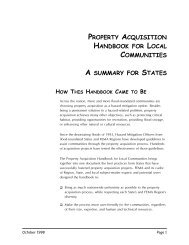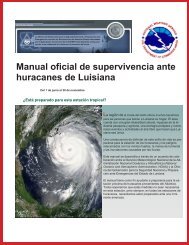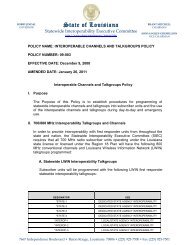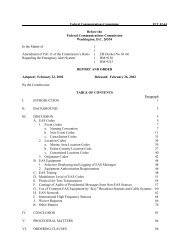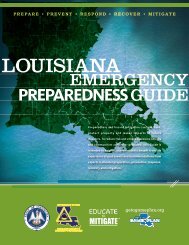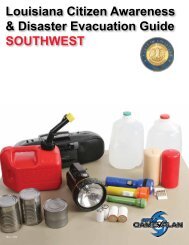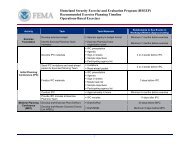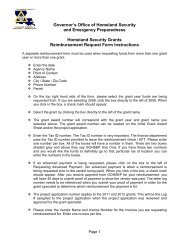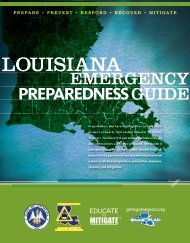Presentation - OEC
Presentation - OEC
Presentation - OEC
You also want an ePaper? Increase the reach of your titles
YUMPU automatically turns print PDFs into web optimized ePapers that Google loves.
Office of Emergency CommunicationsRegional Coordination ProgramMarch 23, 2011Dan Hawkins - PresenterRegional Coordinator, Region VIII – UT, CO, WY, MT, ND, SDOffice of Emergency CommunicationsKen BornRegional Coordinator, Region VI – AR, LA, NM, OK, TXOffice of Emergency CommunicationsMission<strong>OEC</strong> supports and promotes the ability of emergency respondersand government officials to communicate in the event of naturaldisasters, acts of terrorism, or other man-made disasters, andworks to ensure, accelerate, and attain interoperable andoperable emergency communications nationwide.Presenter’s Name June 17, 2003 21
DHS Organizational ChartNational Protectionand ProgramsDirectorate (NPPD)Office ofCybersecurity andCommunications(CS&C)Office of EmergencyCommunications(<strong>OEC</strong>)Presenter’s Name June 17, 2003Regional Coordination ProgramThe Regional Coordination Program supports the <strong>OEC</strong> missionby strengthening emergency communications capabilities acrossFederal, State, local, and tribal governments at the regional levelthrough h trusted t relationships, collaboration, and knowledgesharing.Presenter’s Name June 17, 2003 42
Regional Coordinator Roles• Support the efforts of Federal/State/Local/Tribal to build andimprove emergency communications capabilities across theirregions.• Provide <strong>OEC</strong> with feedback and assessment of emergencycommunications activities, accomplishments, issues, gaps,and constraints across the Nation.• Successfully advocate for identified key <strong>OEC</strong> initiatives,programs, and activities.Presenter’s Name June 17, 2003 5Regional CoordinatorsPresenter’s Name June 17, 20033
<strong>OEC</strong>, FEMA, and NCS• <strong>OEC</strong> RCs collaborate and coordinate with State/Local/Tribal toimprove their emergency communications capabilities andsupport NCS and FEMA in the Federal response to disasters.• FEMA DEC RECCs provide Federal capabilities to supporttactical response during a disaster.• NCS Communications Liaisons provide Federal response andrecovery of commercial communications infrastructure during adisaster.Presenter’s Name June 17, 20037<strong>OEC</strong> ActivitiesNECP• Goal 1 and 2• Documenting Capability• Demonstrating ti Performance<strong>OEC</strong> Technical Assistance• New OfferingsNarrowband• Requirements• Frequency Mapping ToolProject 25 (P25)• Compliance Assessment ProgramBroadbandPresenter’s Name June 17, 20034
<strong>OEC</strong> Technical Assistance (2011)Accepted for 1 st Round of Delivery• National Incident Management System(NIMS)/Incident Command System (ICS)WorkshopAccepted for 2 nd Round of Delivery• All-Hazards Communications Unit Leader(COML) Exercise – Multi-State (TX)• Communications-Focused Full-ScaleExercise (FSE) – Multi-State (TX)Deferred TA Request• TICP Workshop• All-Hazards Communications UnitTechnician (COMT) CoursePresenter’s Name June 17, 2003Contact InformationOffice of Emergency Communications<strong>OEC</strong>@hq.dhs.govKen BornRegional Coordinator, Region VI – AR, LA, NM, OK, TXOffice of Emergency Communications202 641 5033kenneth.born@dhs.govPresenter’s Name June 17, 20035
Presenter’s Name June 17, 2003Backup SlidesPresenter’s Name June 17, 2003 126
<strong>OEC</strong> Technical AssistanceMost Requested Offerings – Top Ten1. Communication Unit Leader (COML) Course2. Interoperability Field Operations Guide (IFOG) Development3. COML Train-the-TrainerT i4. Standard Operating Procedures/Communications Plan Development5. LMR System Analysis6. LMR System Migration7. TICP Workshop8. Operational Communications Assessments9. Communications-Focused Tabletop Exercise (TTX)10.Audio Gateway Information and TrainingPresenter’s Name June 17, 2003 13<strong>OEC</strong> Technical AssistanceNew or Revised Offerings1. Follow-up Statewide Planning Workshop2. Broadband Systems Support3. VHF/UHF Narrow Banding4. Response-Level Communications Workshop5. All-Hazards Communications Unit Leader (COML) Exercise6. Auxiliary Communications Workshop7. Native American Public Safety Communications Needs8. TICP Update Workshop9. Communications Plan Analysis/Event Communications Plan Analysis10. Public Safety Communications Center (PSCC) Planning and Operations11. All-Hazards Communications Unit Technician (COMT) Course12. Introduction to Interoperable Radio Operations13. Principles of Interoperability and the National Interoperability Field Operations Guide (NIFOG)14. Regional Communications Enhancement Support — Strategic Communications Migration Plan (SCMP)Presenter’s Name June 17, 2003 147
Narrowbanding RequirementsPrivate Land Mobile Radio Systems operating below 512 MHzBeginning January 1, 2011, the Commission will no longeraccept applications for:• New wideband 25 kHz (i.e., operating with only one voice path per 25 kHzof spectrum) operations• Modification of existing wideband 25 kHz stations that expands theauthorized interference contourBy January 1, 2013, Industrial/Business and Public SafetyRadio licensees must:• Operate on 12.5 kHz or• Employ a technology that achieves the narrowband equivalent of onevoice channel per 12.5 kHz of channel bandwidth or 4800 bits per secondper 6.25 kHz for data trafficPresenter’s Name June 17, 2003Narrowband TimelinePrivate Land Mobile Radio Systems operating below 512 MHzDocket 92-235NarrowbandingbeginsSecond Report and OrderNo new 25 kHz systemsafter 1/2004Conversion for PS by1/1/2018Jan. 1, 2011All new applications and allmodifications at 12.5 kHz1992 1997 2003 2004 2008 2011 2013FCC type acceptancerequired to be 12.5 kHznarrowband capableFCC establishednew dates fornarrowband of2011 and 2013Jan 1, 2013All licensees must be fullyoperational on 12.5 kHzPresenter’s Name June 17, 2003 168
Presenter’s Name June 17, 2003 17Presenter’s Name June 17, 2003 189
Presenter’s Name June 17, 2003 19Presenter’s Name June 17, 2003 2010




